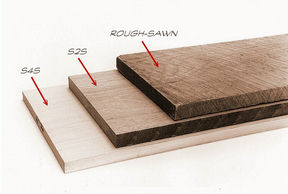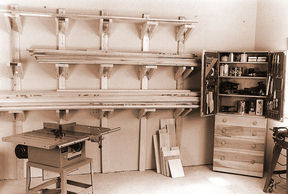 

|
|
|
 ost
craftsmen buy their materials from a lumberyard, sawmill, or a retailer
specializing in woodworkers’ needs. Whatever your source, you usually
have a choice of buying your wood rough or surfaced. Your choices may
include: ost
craftsmen buy their materials from a lumberyard, sawmill, or a retailer
specializing in woodworkers’ needs. Whatever your source, you usually
have a choice of buying your wood rough or surfaced. Your choices may
include:
-
Rough-sawn, with the surfaces untouched since leaving the mill
-
Surfaced on two sides (S2S), with both faces planed
-
Surfaced on four sides (S4S), with both faces planed and both edges
jointed
|
|
|
ROUGH OR SURFACED?
Which
should you choose? Ready-surfaced lumber saves you the time it takes to
plane and joint. But if the wood should cup or bow, you’ll have to live
with the imperfections. Rough-sawn lumber gives you some extra stock so
you can
true
a slightly warped
board, making the surfaces perfectly straight and flat. |

Commercial lumber comes unsurfaced (rough-sawn), face-planed
only (S2S), or face-planed and edge-jointed (S4S).* |
 |
|
PROTECTIVE
WRAPPER -- When purchasing
surfaced lumber, have it planed 1⁄16 inch thicker than what you plan to
use. The extra stock serves as a protective “wrapper.” Wait until you’re
ready to work to plane the wood to its final dimension. You’ll have a
fresh surface, free of stains and dents. |
|
Many craftsmen insist
that you can get truly flat lumber only by surfacing it yourself. But
this can be impractical, especially if you have a small shop and limited
surfacing capabilities. Unless you have a wide jointer and a large
planer, it makes sense to buy surfaced lumber (S2S – surfaced
two sides) for noncritical
parts that don’t have to be perfectly true. When making critical parts
such as door frame members and drawer sides, however, you should always
start with rough lumber and true it.
S4S –
surfaced four sides – stock should be
your last choice. It just isn’t worth the money you pay for jointing the
edges. Provided you have a jointer, you can make much straighter edges
if you joint the parts as you cut them to size. |
SHOP-DRYING
After
purchasing the stock, let it rest in your shop for a week or two (per
inch of thickness) before working with it. The same holds for stock
you’ve stored in a building separate from your shop. Resist the
temptation to get to work immediately — you might have to do a lot of
work over again! |
|
|
LET THE WOOD REACH
EQUILIBRIUM
Wood
typically expands or contracts whenever you change its location, due to
differences in
relative humidity.
When you
first bring a board into your shop, it will be in motion. If you attempt
to work it too soon, problems will result. The surfaces that you plane
perfectly true today may be less than flat by tomorrow. Joints that fit
beautifully on Monday may be nothing to crow about by Friday.
To avoid these
problems, let the wood stabilize in its new environment. Stack it
in a corner or on
a rack until the
moisture content of the wood reaches equilibrium with
the relative humidity in your shop. This is called shop-drying, and it
usually takes just a few days. Most craftsmen wait a week or more to be
safe.
Once
the lumber has stabilized, joint and plane the surfaces straight, flat,
and square to one another. Although jointing and planing are both
surfacing operations, they are actually very different.
 |
Jointing trues a surface and shaves it flat. It also cuts one
surface at a precise angle (usually 90 degrees) to another. |
 |
Planing cuts one surface parallel to another and reduces the stock
to a precise thickness.
|
|

Wood can shop-dry vertically for short periods of time,
leaning against a wall. But if it sits for much longer than a few weeks,
it should be stacked horizontally to keep it as straight as possible.
This simple rack is designed for shop-drying lumber horizontally.* |
|

Back to the top
*Indicates that you
can enlarge a photo by clicking on it. To reveal the information in a "Superphoto,"
first enlarge it and then move the cursor over it. |
|
   |